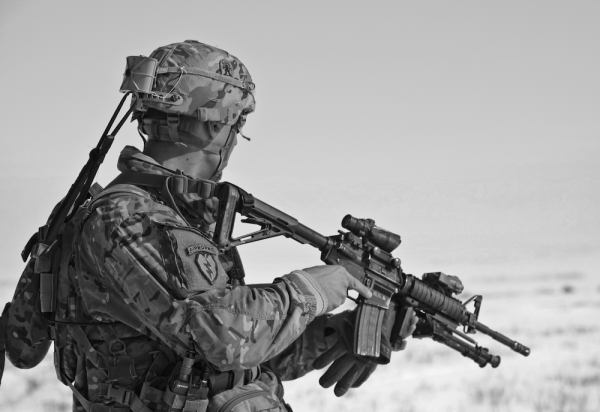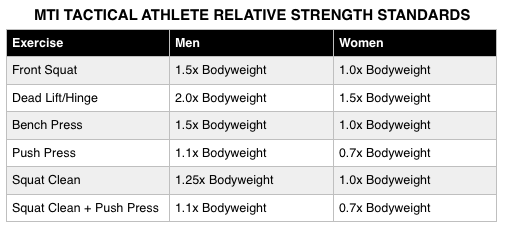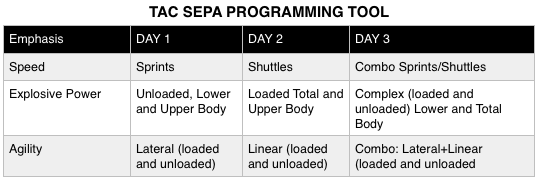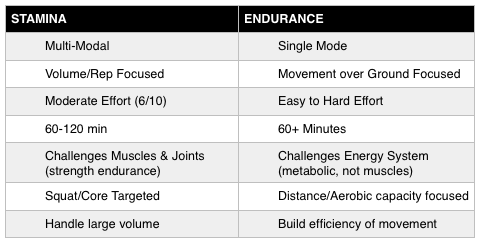
By Rob Shaul
Our theory is continually evolving, and for a while, we’ve been thinking about the different types of tactical athletes, and the different fitness demands for each. Here is where we are now ….

The Five Different Types of Tactical Athletes
We use colors to identify them. We understand some units and tactical athletes won’t perfectly fit any of these categories.
1. Green
Land-based tactical athletes primarily on the military side. Regular Army infantry, Marines, Green Beret, Rangers, UK Royal Marines, SAS, CAG, and most SOF units. Also includes LE SRT/SWAT units with rural mission sets including Border Patrol BORTAC, BORSTAR, DEA FAST, State-wide SRTs, etc. Finally, Green includes wildland firefighters – hotshot crews and smokejumpers.
→Programming for Green: Greek Hero Training Packet
2. Blue
Tactical teams who could have water-based missions (SCUBA) and therefore have a swimming fitness demand. SEAL, DEVGRU, MARSOC, ODA Dive Teams, USAF CCT and PJ’s, etc.
→Programming for Blue: Pirate Training Packet
3. Gray
Primarily LE, urban-based tactical teams – full and part-time municipal SWAT. Mission set is urban-based.
→Programming for Gray: Gun Maker Training Packet
4. Black
Military Police, patrol/detective LE and correction officers. In general, Law enforcement officers without full-time SWAT responsibilities.
→Programming for Black: LE Athlete Spirits Training Packet
5. Red
Fire/Rescue – full-time urban firefighters, busy EMT services, etc.
→Programming for Red: Fire/Rescue Big Cat Training Packet
Fitness Demands
Relative Strength
Relative strength is strength per bodyweight. Tactical athletes don’t need to be as strong as possible. Overemphasis on strength training comes at a cost of other required fitness attributes – especially endurance and work capacity. In terms of relative strength, what we’re after is the strength needed for job performance – with a focus on the “combat chassis” (legs and core), plus a strength “buffer” which helps greatly with durability. I continue to tweak or relative strength standards for tactical athletes – both the exercises and the standards themselves. Within the past 6 months, I’ve tweaked some of the standards to reflect my latest thoughts.
Here is where we’re at now:

We deploy max effort strength training aimed at increasing strength with minimal weight gain. Excess muscle can be a detriment to most tactical athletes as it unnecessarily increases the load they must carry – thus slowing them down. As well, if they become a casualty, unnecessarily muscle mass increases the load their teammates must move for rescue.
Upper Body Hypertrophy
Excess upper body muscle mass is unnecessary most tactical athletes. The exception is for Black – patrol officers, detectives and correctional officers. Studies have shown that a patrol or corrections officer who looks fit and strong can dissuade a would-be bad guy from confrontation. Upper body mass, strength and grip strength can also be key to handling suspects. Upper body hypertrophy programming is a key fitness attribute we currently program into our LE Officer programming.
Work Capacity
High intensity, variable, relatively short (up to 30 minutes) physical efforts which most closely mirror the physical demands of the most intense tactical operations – i.e. fire fights, suspect apprehension, fire knockdowns, personnel rescue, etc. Work capacity is where it all comes together – Relative Strength, cardio, strength endurance, mental fitness. We use strength and conditioning and sport specific gym training to build horsepower (strength, sprint cardio) and staying power (strength endurance, mental fitness, endurance cardio) for work capacity development.
Sprinting ability, and repeat sprint conditioning, under kit load, is a primary work capacity fitness demand for tactical athletes. As we’ve evolved, our work capacity conditioning has become much more sport specific, and now sprints, shuttle sprints, and sprint repeats loaded and unloaded are a work capacity training mode of emphasis.
Endurance – Rucking
Rucking ability – i.e. movement under load in addition to kit, is needed by Green and Blue athletes for patrols, infill, etc. We train rucking ability using both short, fast, intervals, and long, slow efforts at loads from 35-75 pounds. Endurance conditioning is mode specific – not all cardio is equal. Transfer from one mode to another (rowing to rucking, for example) is limited.
As well, we’ve found there to be a significant combat chassis strength demand for rucking (core/legs), which is best built by doing the activity. Finally, extended rucking demands significant joint and connective tissue strength and strength endurance (hips, knees, ankles).
We approach ruck programming two ways: (1) speed over ground improvement using short, fast, intervals, and; (2) aerobic base development using long, slow efforts. The aerobic base work is designed to make athletes’ “slow mode, faster” as well as develop joint and connective tissue strength.
Endurance – Swimming
Blue tactical athletes have a swim-based mission demand. Last Fall we began experimenting with pool-based swim and fin training on the tactical side. In general, our approach is same as that for rucking – speed-over-ground focused intervals, and long, slow efforts to develop mode specific aerobic base. A significant component of a Blue tactical athlete’s swimming training should be completed in fins to keep hip flexors and lower legs fit for SCUBA.
TAC SEPA
This is an acronym for “Tactical Speed, Explosive Power and Agility.” To date, agility work for tactical athletes has been re-tread agility drills and methodologies developed for stick and ball athletes. TAC SEPA is our evolving theory to develop tactically-specific agility standards, exercise methodologies and programming. This theory is still in it’s infancy, and we’ve just begun developing TAC SEPA training sessions and testing them on our Wyoming lab rats.
Below is the outline of our current programming approach:

Chassis Integrity
Another recent addition to our programming theory, we developed the concept of “Chassis Integrity” last Summer when we began to question our approach to core strength training. Core strength training has always been major emphasis on our programming, but until the development of Chassis Integrity, we had trained the core largely in isolation from the rest of the body. We noticed a disconnect, both in strength and motor control, between core strength and loaded exercises with a significant core demand. Chassis integrity is our effort to address this issue.
Again, this theory is in its infancy, but here is where we’re at now:
Chassis Integrity Circuits:
- All training completed from standing or kneeling
- Often long, timed-based efforts, rather than round and rep based
- 3 Types of core exercises:
Total Body (exp. Sandbag Getup, Sandbag Toss and Chase)
Rotational (exp. Sandbag Keg Lift, Standing Russian Twist)
Anti-Rotation (exp. 1-Sided Dead Lift, Kneeling Plate Halfmoon)
Stamina
Stamina programming has two goals:
- Train Recovery from long events.
It’s been our experience that relatively short, intense, work capacity training does do a good job of preparing an athlete for a single, long, endurance push. But he’ll be trashed the next day. His muscles, especially legs, aren’t used to this much volume, and won’t recover overnight. Short, intense events don’t train recovery. - Train mental attitude toward long events or multiple events over a long day
Tactical events are often most dangerous when athletes are tired and beat down from long days, multiple events, etc. Staying tactically sharp in this situation is mental stamina. As well, long, extended events, and multiple events over a long period work to grind down tactical athletes mentally as well as physically. This is where attitude stamina comes in. Attitude stamina is the ability to face each oncoming event with an unemotional, professional, workman-like frame of mind. I.e. “Embrace the Suck.”
Often, coaches and athletes confuse Stamina and Endurance.
Here’s the difference:

Previously, we’ve limited our stamina session programming to focused, intense, 2-week long Stamina cycles. However, most recently we’ve begun to program stamina sessions into strength, work capacity and endurance cycles.
COMMON QUESTIONS
Distance running isn’t one of the fitness attributes, but distance running is programmed frequently in your Operator Sessions and a little in your LE Officer sessions. What gives?
In an actual event, tactical athletes won’t be running, unloaded, in shorts and a t-shirt. And for years, this reality leads to us infrequently programming running. This began changing two years ago when we realized there was a “hole” in our programming on the endurance side – especially rucking. As well, with the military drawdown from Iraq and Afghanistan came a greater emphasis on garrison life, and subsequent emphasis on unloaded running for PT and assessments – and our athletes were asking for programming. What we found was significant transfer from distance running fitness to rucking performance. The two modes complement each other and allowed us to mix up our Green athlete endurance programming and improve rucking performance without constant impact from the ruck. As well, adding running addressed garrisoned athletes’ need to develop their running fitness. Finally, when we began seriously programming endurance, we found outside endurance work a welcome break from the gym and this helped address the “burden of constant fitness,” which faces all tactical athletes.
Why do you program Step Ups?
We don’t think of step ups so much as another endurance mode, but rather a subset of rucking. Step ups train the movement-specific strength and cardio for uphill movement under load: i.e. loaded patrols in Afghanistan and other mountainous areas.
Years of coaching experience working with tactical athletes and our lab rats, as well as our own biases as individual coaches.
We’ve found it simpler for most athletes to learn than the Power Clean, and we felt we needed a power-focused strength exercise standard.
Questions, Comments, Feedback? Email coach@mtntactical.com
You Might Also Like MTI’s Top 5 Exercises for Military Athletes Training Plan
